SAAB 9-3 2005 User Guide
Manufacturer: SAAB, Model Year: 2005, Model line: 9-3, Model: SAAB 9-3 2005Pages: 292, PDF Size: 23 MB
Page 11 of 292
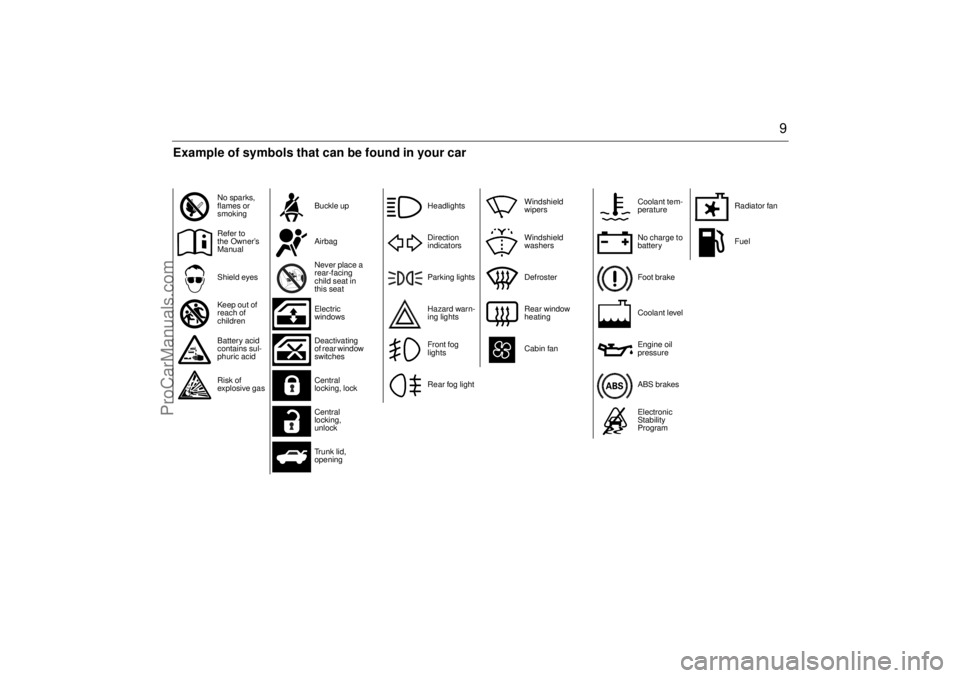
9
No sparks,
flames or
smokingBuckle up
Refer to
the Owner’s
ManualAirbag
Shield eyesNever place a
rear-facing
child seat in
this seat
Keep out of
reach of
childrenElectric
windows
Battery acid
contains sul-
phuric acidDeactivating
of rear window
switches
Risk of
explosive gasCentral
locking, lock
Central
locking,
unlock
Trunk lid,
opening
HeadlightsWindshield
wipers
Direction
indicatorsWindshield
washers
Parking lights Defroster
Hazard warn-
ing lightsRear window
heating
Front fog
lightsCabin fan
Rear fog light
Coolant tem-
peratureRadiator fan
No charge to
batteryFuel
Foot brake
Coolant level
Engine oil
pressure
ABS brakes
Electronic
Stability
Program
Example of symbols that can be found in your car
ProCarManuals.com
Page 12 of 292

10(This page has been left blank.)
ProCarManuals.com
Page 13 of 292

11 Safety
Safety belts ___________ 12
Seats ________________ 17
Head restraints ________ 21
Child safety ___________ 22
Airbag________________ 29
Safety
ProCarManuals.com
Page 14 of 292
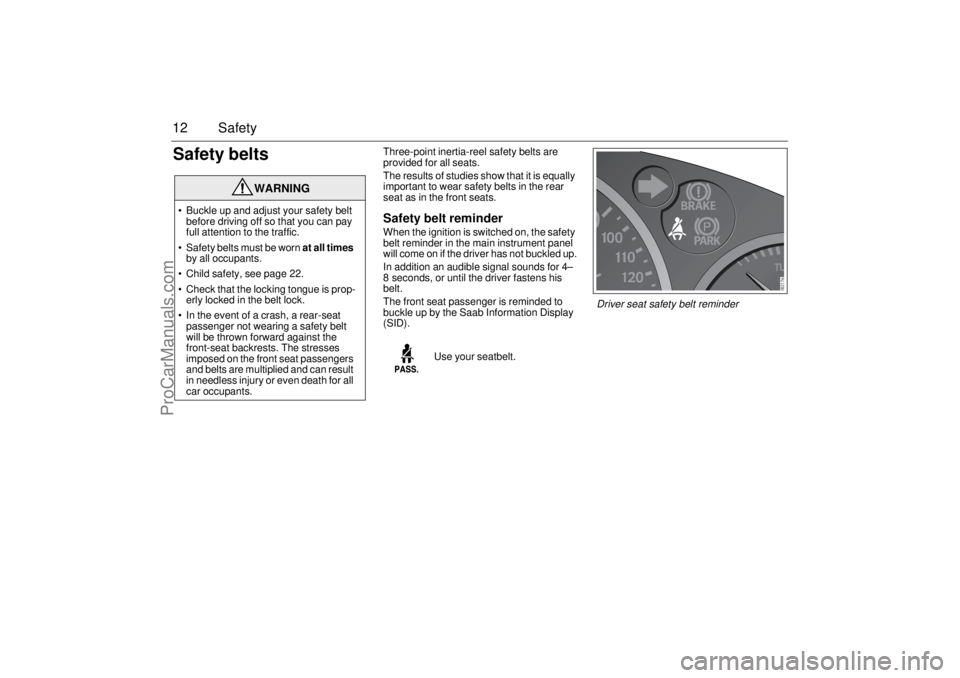
12 SafetySafety belts
Three-point inertia-reel safety belts are
provided for all seats.
The results of studies show that it is equally
important to wear safety belts in the rear
seat as in the front seats.Safety belt reminderWhen the ignition is switched on, the safety
belt reminder in the main instrument panel
will come on if the driver has not buckled up.
In addition an audible signal sounds for 4–
8 seconds, or until the driver fastens his
belt.
The front seat passenger is reminded to
buckle up by the Saab Information Display
(SID).
WARNING
Buckle up and adjust your safety belt
before driving off so that you can pay
full attention to the traffic.
Safety belts must be worn at all times
by all occupants.
Child safety, see page 22.
Check that the locking tongue is prop-
erly locked in the belt lock.
In the event of a crash, a rear-seat
passenger not wearing a safety belt
will be thrown forward against the
front-seat backrests. The stresses
imposed on the front seat passengers
and belts are multiplied and can result
in needless injury or even death for all
car occupants.
Use your seatbelt.
Driver seat safety belt reminder
ProCarManuals.com
Page 15 of 292

13 Safety
Correct position for safety beltConsider this:
Position the lap strap snugly and low
across the hips so that it just touches the
thighs.
The shoulder strap must be as far in on
the shoulder as possible.
Check to ensure that the belt is not twisted
or rubbing against any sharp edges.
There should not be any slack in the belt.
Pull the belt tight – particularly important
when thick outer clothing is worn. It is advisable to remove thick items of
clothing.
Refrain from tilting the backrest more than
necessary, as the safety belt provides
better protection when the seat is in the
more upright position.
Only one person per safety belt!
For most of the time a safety belt is worn,
the retractor will allow the wearer freedom
of movement. The retractor locks up auto-
matically if the belt is jerked or withdrawn
sharply, the car tilts, the brakes are
applied hard or a crash occurs.
Children up to 6 years of age must always
be seated in a child seat. Saab recom-
mends the use of a child seat for children
up to the age of 10.
Children who have grown out of a child
seat should be restrained by the car’s
standard three-point belts. Make sure that
the shoulder belt is not in contact with the
neck or throat. If it is, a booster seat/cush-
ion may be necessary.
WARNING
Proper positioning of the safety belt is
extremely important.
An out of position safety belt can result
in the wearer sliding underneath the
belt in a crash (submarining) and
injury can result from the lap portion
cutting into the abdomen.
Never fasten the safety belt with the
shoulder belt behind the body or pull
the belt off the shoulder and under the
arm.
Two people must never share one
safety belt. In the event of a crash
those sharing a belt risk being crushed
together and injured.
Correct seating position
ProCarManuals.com
Page 16 of 292
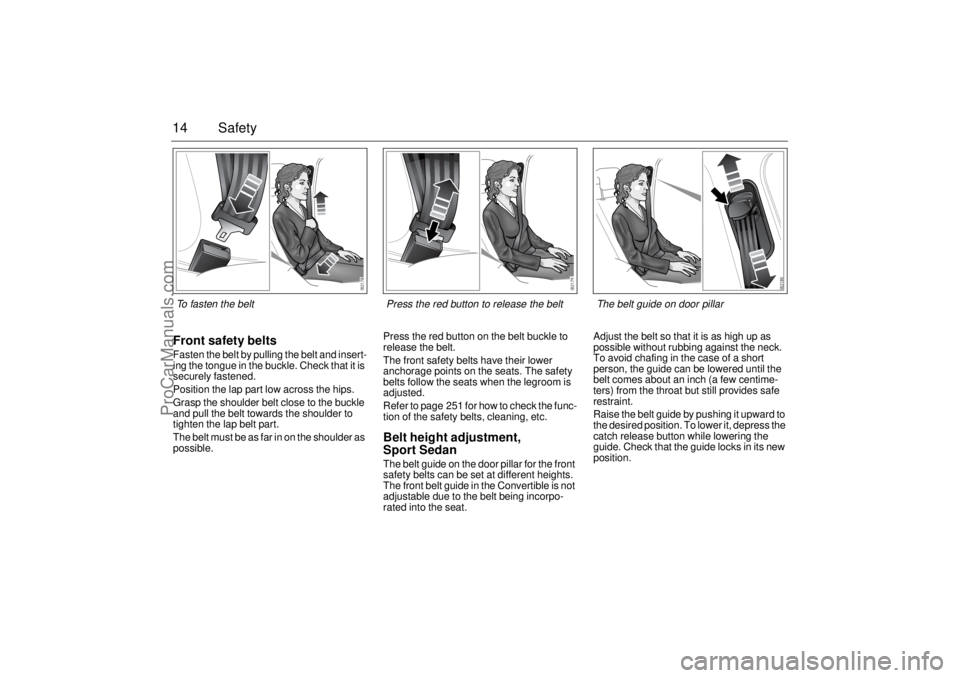
14 SafetyFront safety beltsFasten the belt by pulling the belt and insert-
ing the tongue in the buckle. Check that it is
securely fastened.
Position the lap part low across the hips.
Grasp the shoulder belt close to the buckle
and pull the belt towards the shoulder to
tighten the lap belt part.
The belt must be as far in on the shoulder as
possible.Press the red button on the belt buckle to
release the belt.
The front safety belts have their lower
anchorage points on the seats. The safety
belts follow the seats when the legroom is
adjusted.
Refer to page 251 for how to check the func-
tion of the safety belts, cleaning, etc.
Belt height adjustment,
Sport SedanThe belt guide on the door pillar for the front
safety belts can be set at different heights.
The front belt guide in the Convertible is not
adjustable due to the belt being incorpo-
rated into the seat.Adjust the belt so that it is as high up as
possible without rubbing against the neck.
To avoid chafing in the case of a short
person, the guide can be lowered until the
belt comes about an inch (a few centime-
ters) from the throat but still provides safe
restraint.
Raise the belt guide by pushing it upward to
the desired position. To lower it, depress the
catch release button while lowering the
guide. Check that the guide locks in its new
position.
To fasten the belt Press the red button to release the belt
The belt guide on door pillar
ProCarManuals.com
Page 17 of 292
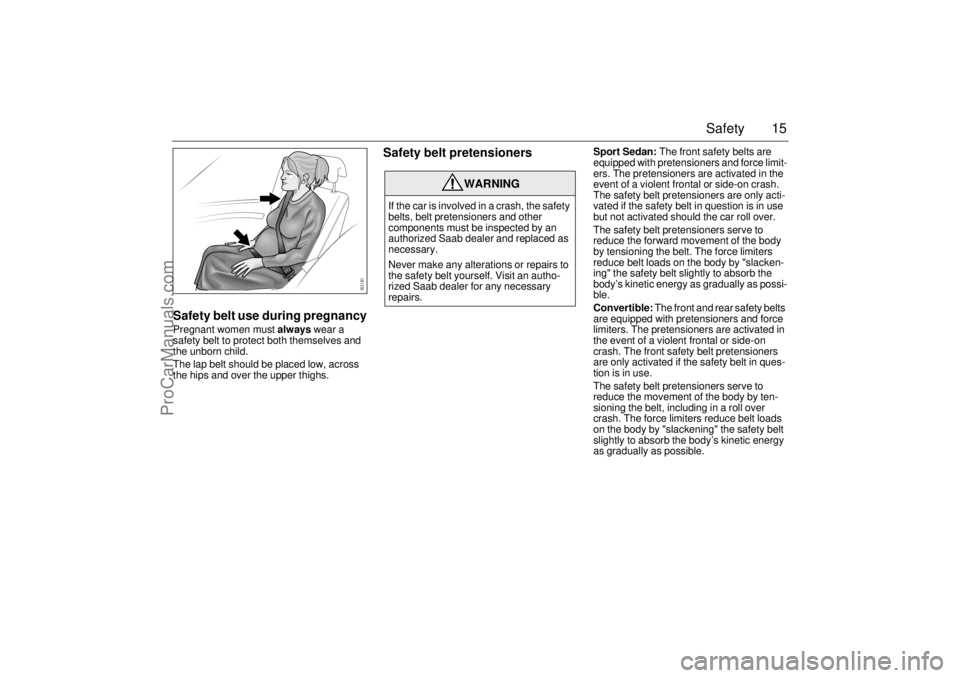
15 Safety
Safety belt use during pregnancyPregnant women must always wear a
safety belt to protect both themselves and
the unborn child.
The lap belt should be placed low, across
the hips and over the upper thighs.
Safety belt pretensioners
Sport Sedan: The front safety belts are
equipped with pretensioners and force limit-
ers. The pretensioners are activated in the
event of a violent frontal or side-on crash.
The safety belt pretensioners are only acti-
vated if the safety belt in question is in use
but not activated should the car roll over.
The safety belt pretensioners serve to
reduce the forward movement of the body
by tensioning the belt. The force limiters
reduce belt loads on the body by "slacken-
ing" the safety belt slightly to absorb the
body’s kinetic energy as gradually as possi-
ble.
Convertible: The front and rear safety belts
are equipped with pretensioners and force
limiters. The pretensioners are activated in
the event of a violent frontal or side-on
crash. The front safety belt pretensioners
are only activated if the safety belt in ques-
tion is in use.
The safety belt pretensioners serve to
reduce the movement of the body by ten-
sioning the belt, including in a roll over
crash. The force limiters reduce belt loads
on the body by "slackening" the safety belt
slightly to absorb the body’s kinetic energy
as gradually as possible.
WARNING
If the car is involved in a crash, the safety
belts, belt pretensioners and other
components must be inspected by an
authorized Saab dealer and replaced as
necessary.
Never make any alterations or repairs to
the safety belt yourself. Visit an autho-
rized Saab dealer for any necessary
repairs.
ProCarManuals.com
Page 18 of 292
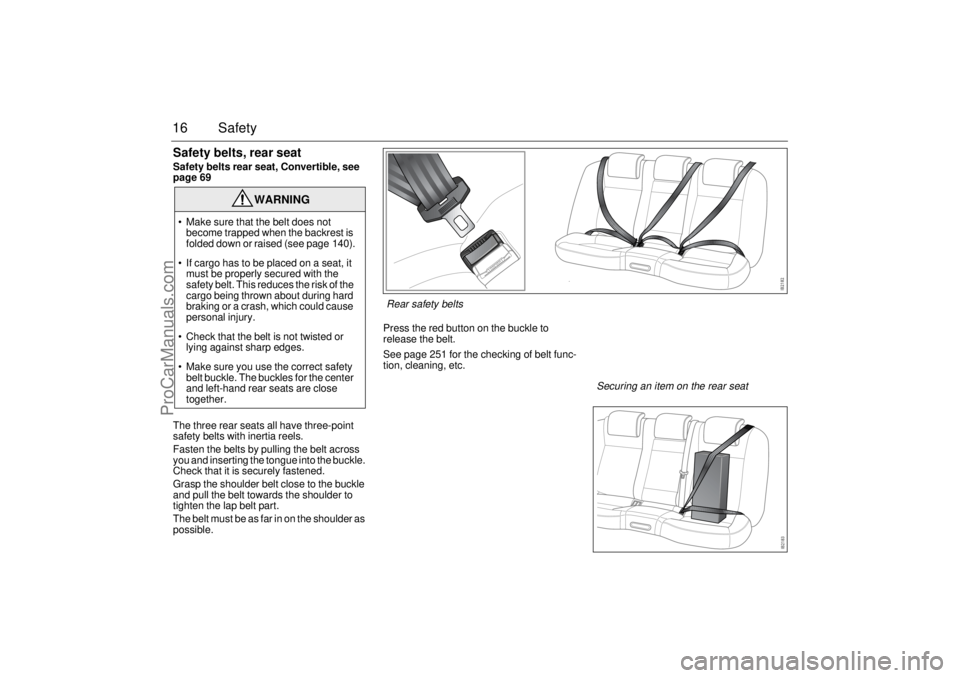
16 SafetySafety belts, rear seatSafety belts rear seat, Convertible, see
page 69
The three rear seats all have three-point
safety belts with inertia reels.
Fasten the belts by pulling the belt across
you and inserting the tongue into the buckle.
Check that it is securely fastened.
Grasp the shoulder belt close to the buckle
and pull the belt towards the shoulder to
tighten the lap belt part.
The belt must be as far in on the shoulder as
possible.Press the red button on the buckle to
release the belt.
See page 251 for the checking of belt func-
tion, cleaning, etc.
WARNING
Make sure that the belt does not
become trapped when the backrest is
folded down or raised (see page 140).
If cargo has to be placed on a seat, it
must be properly secured with the
safety belt. This reduces the risk of the
cargo being thrown about during hard
braking or a crash, which could cause
personal injury.
Check that the belt is not twisted or
lying against sharp edges.
Make sure you use the correct safety
belt buckle. The buckles for the center
and left-hand rear seats are close
together.
Rear safety belts
Securing an item on the rear seat
ProCarManuals.com
Page 19 of 292

17 Safety
SeatsManually adjusted front seats(if equipped)
The following front seat adjustments can be
made to achieve a comfortable driving
position:
Height
Sport Sedan - driver’s seat
Convertible - both seats
Legroom
Sport Sedan - both seats
Convertible - both seats
Backrest rake angle
Sport Sedan - both seats
Convertible - both seats
Lumbar support firmness
Sport Sedan - driver’s seat
Convertible - only electrically adjustable
front seats
Head restraint height
Sport Sedan - both seats
Convertible - both seatsWe recommend that adjustments to the
driver’s seat be performed in the following
order:
1Height
2 Legroom
3 Backrest rake angle
4 Head restraint height
Lastly, adjust the position of the steering
wheel (see page 122).
Electrically adjustable front seats
See page 19.
Electric heating, front seats (option)
See pages 107 and 116.
Height adjustmentSport Sedan, driver’s seat
Convertible, both front seats
Lift the lever to raise the seat. The lever is
spring-loaded to return to its neutral posi-
tion. Repeated lifting of the lever will
increase the height in steps.
Press down the lever to lower the seat.
Repeated downward presses of the lever
will lower the seat in steps.
WARNING
Never adjust the driver’s seat except
when the car is stationary.
ProCarManuals.com
Page 20 of 292
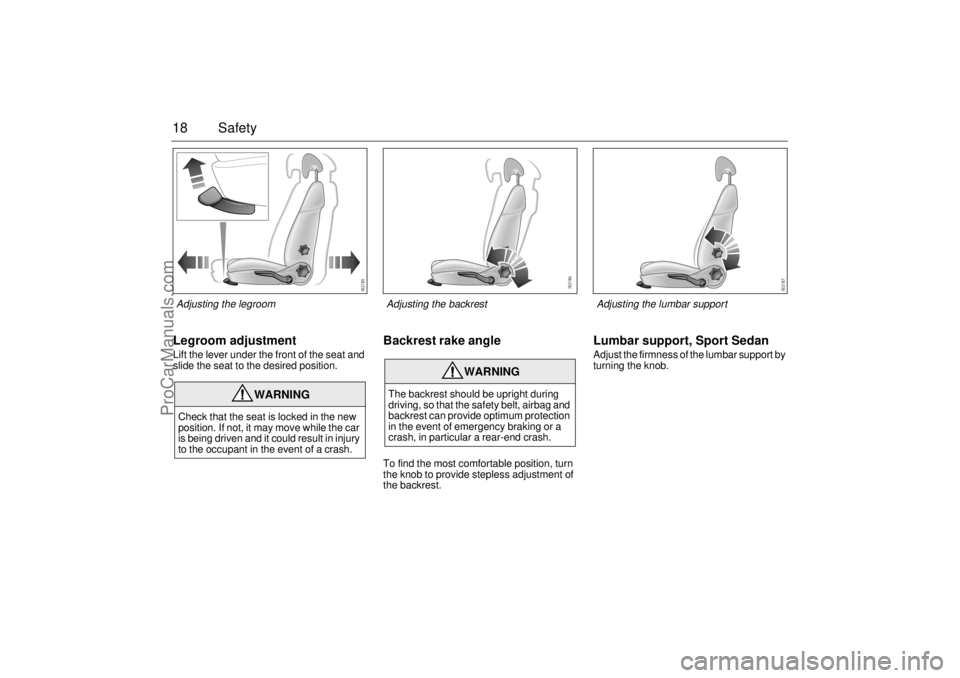
18 SafetyLegroom adjustmentLift the lever under the front of the seat and
slide the seat to the desired position.
Backrest rake angleTo find the most comfortable position, turn
the knob to provide stepless adjustment of
the backrest.
Lumbar support, Sport SedanAdjust the firmness of the lumbar support by
turning the knob.
WARNING
Check that the seat is locked in the new
position. If not, it may move while the car
is being driven and it could result in injury
to the occupant in the event of a crash.
WARNING
The backrest should be upright during
driving, so that the safety belt, airbag and
backrest can provide optimum protection
in the event of emergency braking or a
crash, in particular a rear-end crash.Adjusting the backrest
Adjusting the legroom Adjusting the lumbar support
ProCarManuals.com